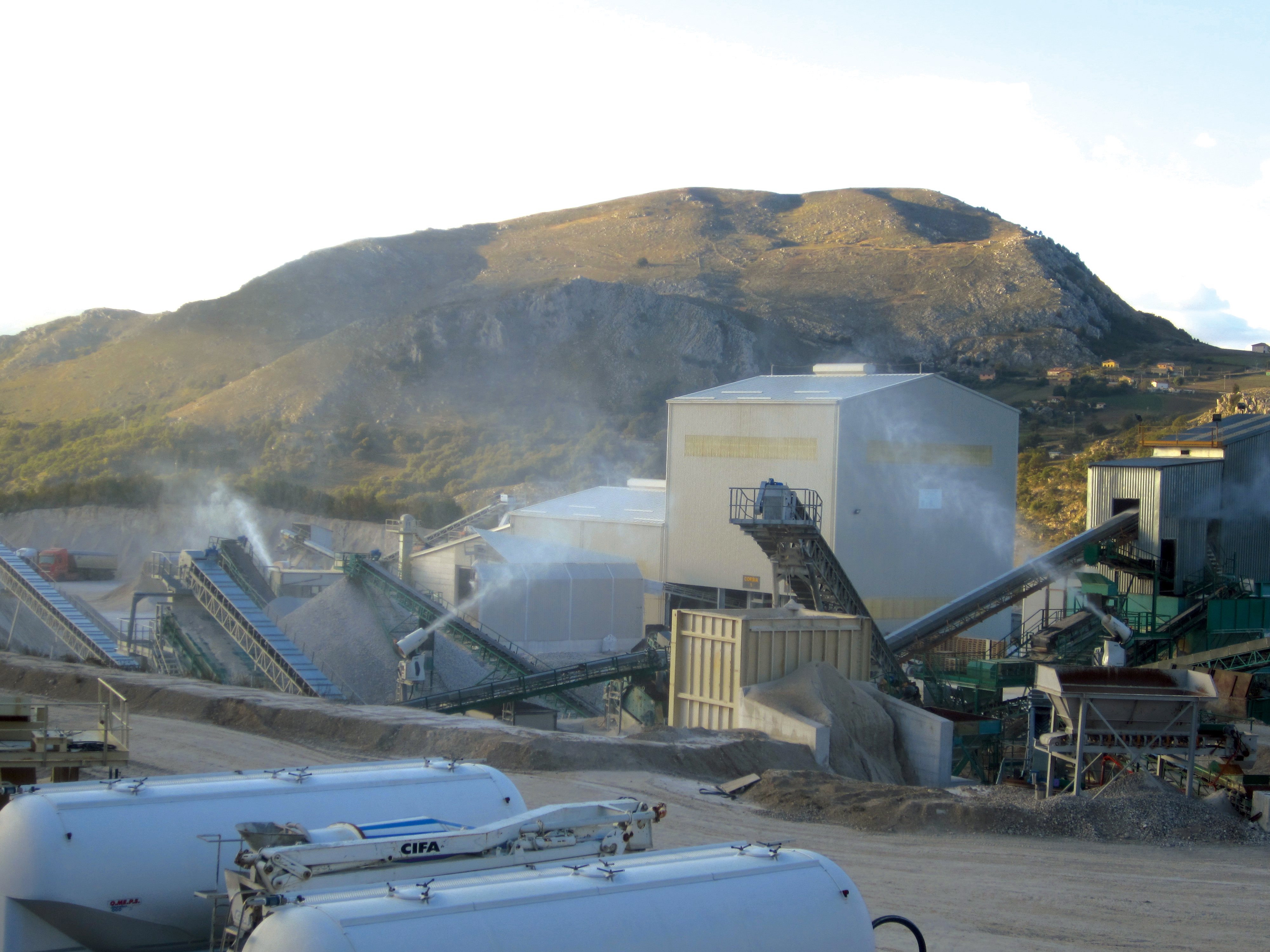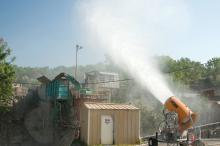
Dust from quarries tends to be unavoidable, particularly when the weather is very dry.
Activities, including the drilling, blasting, loading, hauling, conveying and crushing and screening of rocks all generate dust as does transporting the finished products.
According to Sustainable Aggregates in the UK, predicting the level of dust emission is extremely difficult because of the complex nature of mineral operations and the variable dispersion and dilution characteristics of dust in the air.
“This clearly presents problems for development approval. Heavy reliance is therefore made on minimising dust production through good practice and monitoring actual dust emissions,” says the organisation.
“In order to fully describe deposition patterns, long-term and detailed dust monitoring would be required. Dust patterns are often characterised by few or occasional short-lived dusting events comprising high levels of dust deposition largely caused by particular, and possibly infrequent, combinations of wind and rainfall conditions. At other times dust deposition from the mineral site itself may be low or insignificant, but a property/receptor is still likely to be subject to background and other dust sources. As such it is often important to be able to differentiate dust from multiple sources (and therefore a need to monitor for direction, colour and possibly mineralogy) and to correlate this with site specific meteorological data.
“As monitoring is conducted for both health and nuisance purposes the sophistication of different monitoring techniques differs greatly. The different monitoring methods can be divided into two categories: active systems and passive systems. The nature of the two types of systems means that active systems are more suited to measuring over minutes, hours and days whereas passive systems are best suited for measuring over days weeks and months.”
Monitoring can include recording all blasts on video to monitor dust in relation to wind strength and direction; taking air samples; equipment that may be configured to notify in case prescribed levels are exceeded or weather stations to provide information about wind strength, wind direction and ground level moisture or long-range weather forecasts to allow quarry activities to be scheduled.
While quarry dust is undesirable, research, testing and its use as a replacement for natural sand in concrete production is well documented.
However, it still has to be dealt with satisfactorily, and many quarries use specialist equipment developed to keep dust levels down.
For years dolomite has been the main rock extracted from the Cava la Pedicara quarry in the province of Basilicata in the south of Italy.
Large amounts of dust were generated during the quarrying work, so the managers opted for a customised solution in a bid to counteract the problem.
Selecting a solution from
The quarrying generated large clouds of dust particles, polluting the air for people and nature.
The aims of the project were ambitious, covering a large area over which to start reducing the spread of dust, particularly without disrupting the quarrying process.
In order to achieve the aims every single source of dust was individually analysed with a view to adopting an efficient strategy to combat it. The resulting solution is a combined system comprising dust-laying sprayers, fixed sprinklers and water curtains.
Two V12 dust-laying sprayers from EmiControls were installed on lifts at two strategic points. The optimum heights for the lifts were calculated to be 4.5m and 6m, thus allowing the pivot facility of the dust-laying sprayers to be used to full effect and to cover a large area. The lift machines can be controlled by radio and remote console. A mobile V7 is used for relatively small sources of dust if required.
A device with fixed nozzles has been fitted at the conveyor belt discharge points, a solution developed especially for this application. The fine mist can bind the dust from above and therefore directly at its source.
The screening process used to create large amounts of dust, and in this regard there was the added challenge: direct contact with the spray would wet the material and therefore disrupt the working process. The problem was solved with a water curtain which prevents the dust from the screening machines from escaping into the air without affecting the material.
The water is distributed over the site by means of a central pumping plant, while booster pumps have been fitted in the outside areas.
With the work now completed, the results are said to be “entirely satisfactory.”
“Dust levels in the Cava la Pedicara quarry are now virtually zero, which is great news for the employees and the environment. The reduction in dust levels is also good news for the machinery which is no longer required to work quite so hard,” says EmiControls.
Such dust Controls systems are high-tech applications, and to maintain the present standards, a service contract for regular maintenance work has been signed.
While EmiControls has a worldwide service network providing immediate technical support should any queries or problems arise, at Cava la Pedicara a local partner company, with EmiControls trained staff, will be taking care of the regular servicing work for the operator.
In another development, Inmalo, which specializes in demolition attachments and dust suppression, recently supplied its first Motofog MF40D dust suppression unit into the UK.
The recently launched trolley-mounted unit, fitted with a Hatz diesel engine, only needs connection to a water supply to be operational.
The first unit has been taken on hire by Hughes and Salvidge for a prestigious contract airside at Heathrow Airport, London.
“At 207kg, the unit makes it easy for one person to move and, aided by large tyres, means that uneven ground may be traversed with relative ease. It can also be easily craned using the central lifting eye,” says Inmalo.
The MF40D projects a mist of water up to 35m to dampen airborne dust particles, and the head is fitted with dual nozzles for either a pencil jet or wider spray option. The head can be rotated by joystick on the unit or by remote control (optional), which has a range of over 100m. The remote control will operate all the functions including engine stop/start and spray directional Controls.
Earlier this year
French construction giant Vinci, working in a Corsican quarry, where water-based dust suppression was vital, saw its water supply diminish until work stopped.
DF Technology remanufactured the DF15000 with internal parts made from stainless steel to avoid sea water corrosion and added a purpose-built nebuliser to produce a precise spray ready to render the area free from harmful substances.
The company has now received a major order from European rental giant Boels Rental for 20 of its DF Smart portable dust suppression units.
Dutch company Boels Rental, with over 300 locations in the Netherlands, Belgium, Luxembourg, Germany, Austria, Czech Republic, Poland, Italy and Slovakia, is regarded as one of the leading European rental companies, and already has an extensive fleet of
The DF Ecology range came to Boels attention at this year’s
The DF Smart is designed to provide workers with safe protection from many different kinds of airborne contaminates, producing a fine mist of water through a series of high-pressure jets. This is propelled onto the site by a powerful fan, rendering the area free from unhealthy and hazardous material.
Meanwhile, Oakwood Demolition decided to evaluate its current arrangements for controlling dust on site after looking at ACE Plant’s Dust Fighter range, bought a Dust Fighter DF75000MPT, a complete dust suppression unit that produces a fine mist of water through a series of high-pressure jets.
The mist is propelled onto the site by a powerful fan, covering a wide area in just a few moments, rendering the area free from unhealthy and hazardous material.
“On past contracts we have made do with our own fan-based dust suppression set, but when we added up the costs and the inconvenience of having to gather together a generating set, cables, hoses and pressured water feeds that are required to operate our old fan system, the decision to purchase an all-in-one Dust Fighter from ACE Plant became obvious,” says Mike Hughes, service director at London, UK-based Oakwood Demolition.
The DF75000MPT, powered by an on-board 22kVA generator and an integral 2,000litre stainless steel tank, is entirely self-contained.
It offers a coverage range of around 60m and its water consumption can be as low as 10litres/minute, while the unit can also be remotely controlled.







